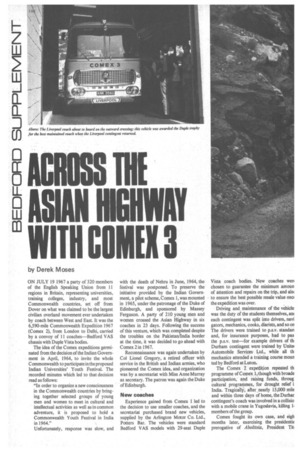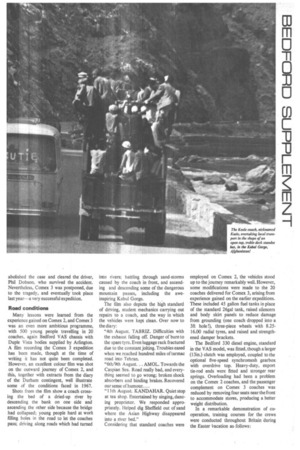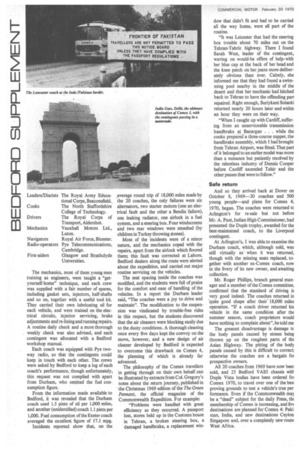E ACME THE ` 1 8 ASIAN IHWAY
Page 142

Page 143

Page 144

If you've noticed an error in this article please click here to report it so we can fix it.
WITH COMB( 3
by Derek Moses
ON JULY 19 1967 a party of 320 members of the English Speaking Union from 11 regions in Britain, representing universities, training colleges, industry, and most Commonwealth countries, set off from Dover on what was claimed to be the largest civilian overland movement ever undertaken by coach between West and East. It was the 6,590-mile Commonwealth Expedition 1967 (Comex 2), from London to Delhi, carried by a convoy of 11 coaches—Bedford VAS chassis with Duple Vista bodies.
The idea of the Comex expeditions germinated from the decision of the Indian Government in April, 1964, to invite the whole Commonwealth to participate in the proposed Indian Universities' Youth Festival. The recorded minutes which led to that decision read as follows: "In order to organize a new consciousness in the Commonwealth countries by bringing together selected groups of young men and women to meet in cultural and intellectual activities as well as in common adventure, it is proposed to hold a Commonwealth Youth Festival in India in 1964."
Unfortunately, response was slow, and with the death of Nehru in June, 1964, the festival was postponed. To preserve the initiative provided by the Indian Government, a pilot scheme, Comex 1, was mounted in 1965, under the patronage of the Duke of Edinburgh, and sponsored by Massey Ferguson. A party of 210 young men and women crossed the Asian Highway in six coaches in 23 days. Following the success of this venture, which was completed despite the troubles on the Pakistan/India border at the time, it was decided to go ahead with Comex 2 in 1967.
Reconnaissance was again undertaken by Col Lionel Gregory, a retired officer with service in the British and Indian armies, who pioneered the Comex idea, and organization was by a secretariat with Miss Anne Murray as secretary. The patron was again the Duke of Edinburgh.
New coaches
Experience gained from Comex 1 led to the decision to use smaller coaches, and the secretariat purchased brand new vehicles, supplied by the Arlington Motor Co. Ltd., Potters Bar. The vehicles were standard Bedford VAS models with 29-seat Duple Vista coach bodies. New coaches wen chosen to guarantee the minimum atnoun of attention and repairs on the trip, and als( to ensure the best possible resale value ono the expedition was over. Driving and maintenance of the vehicle was the duty of the students themselves, an each contingent was split into drivers, navi gators, mechanics, cooks, diarists, and so on The drivers were trained to p.s.v. standar( and, for insurance purposes, had to pas the p.s.v. test—for example drivers of th Durham contingent were trained by Unito Automobile Services Ltd., while all th mechanics attended a training course moun ted by Bedford at Luton.
The Comex 2 expedition repeated th programme of Comex 1, though with broade participation, and raising funds, throug cultural programmes, for drought relief i India. Tragically, after, nearly 15,000 mile and within three days of home, the Durhar contingent's coach was involved in a coffisio with a mobile crane in Yugoslavia, killing 1, members of the group.
Comex fought its own case, and eigh months later, exercising the presidentk prerogative of Abolitsia, President Tit
abolished the case and cleared the driver, Phil Dobson. who survived the accident. Nevertheless, Comex 3 was postponed, due to the tragedy, and eventually took place last year a very successful expedition.
Road conditions Many lessons were learned from the experience gained on Comex 2, and Comex 3 was an even more ambitious programme, with 500 young people travelling in 20 coaches, again Bedford VAS chassis with Duple Vista bodies supplied by Arlington. A film recording the Comex 3 expedition has been made, though at the time of writing it has not quite been completed. However, an excellent colour film was shot on the outward journey of Comex 2, and this, together with extracts from the diary of the Durham contingent, well illustrate some of the conditions faced in 1967.
Shots from the film show a coach crossing the bed of a dried-up river by descending the bank on one side and ascending the other side because the bridge had collapsed; young people hard at work filling holes in the road to let the coaches pass; driving along roads which had turned into rivers; battling through sand-storms caused by the coach in front, and ascending and descending some of the dangerous mountain passes, including the aweinspiring Kabul Gorge.
The film also depicts the high standard of driving, student mechanics carrying out repairs to a coach, and the way in which the vehicles were kept clean. Over now to the diary: "4th August. TABRIZ. Difficulties with the exhaust falling off. Danger of burn to the spare tyre. Even luggage rack fractured due to the constant jolting. Troubles eased when we reached hundred miles of tarmac road into Tehran.
"6thi9th August. .. AMOL. Towards the Caspian Sea. Road really bad, and everything seemed to go wrong; broken shock absorbers and binding brakes. Recovered our sense of humour....
"11th August. KANDAHAR. Quiet stop at tea shop. Entertained by singing, dancing proprietor. We responded appropriately. Helped dig Sheffield out of sand where the Asian Highway disappeared into a river bed."
Considering that standard coaches were employed on Comex 2, the vehicles stood up to the journey remarkably well. However, some modifications were made to the 20 coaches delivered for Comex 3, arising from experience gained on the earlier expeditions. These included 45 gallon fuel tanks in place of the standard 26gal tank, raised silencers and body skirt panels to reduce damage from grounding (one coach dropped into a 3ft hole !), three-piece wheels with 8.2516.00 radial tyres, and raised and strengthened damper brackets.
The Bedford 330 diesel engine, standard in the VAS model, was fitted, though a larger (13in.) clutch was employed, coupled to the optional five-speed synchromesh gearbox with overdrive top. Heavy-duty, export tie-rod ends were fitted and stronger rear springs. Overloading had been a problem on the Comex 2 coaches, and the passenger complement on Comex 3 coaches was reduced by removing four seats near the front to accommodate stores, producing a better weight distribution.
In a remarkable demonstration of cooperation, training courses for the crews were conducted throughout Britain during the Easter Vacation as follows: The mechanics, most of them young men training as engineers, were taught a "getyourself-home" technique, and each crew was supplied with a fair number of spares, including gasket sets, injectors, half-shafts and so on, together with a useful tool kit. They carried their own lubricating oil for each vehicle, and were trained on the electrical circuits, injector servicing, brake adjustments and re-lining and running repairs. A routine daily check and a more thorough weekly check was also advised, and each contingent was allocated with a Bedford workshop manual.
Each coach was equipped with Pye twoway radio, so that the contingents could keep in touch with each other. The crews were asked by Bedford to keep a log of each coach's performance, though unfortunately, this request was not complied with apart from Durham, who omitted the fuel consumption figure.
From the information made available to Bedford, it was revealed that the Durham coach used 1.5 pints of oil per 1,000 miles, and another (unidentified) coach 1.1 pints per 1,000. Fuel consumption of the Exeter coach averaged the excellent figure of 17.1 mpg.
Incidents reported show that, on the ,average round trip of 18,000 miles made by the 20 coaches, the only failures were six alternators, two starter motors (one an electrical fault and the other a Bendix failure), one leaking radiator, one airlock in a fuel system, and a steering box. Four windscreens and two rear windows were smashed (by children in Turkey throwing stones).
Most of the incidents were of a minor nature, and the mechanics coped with the repairs, apart from the airlock which floored them; this fault was corrected at Lahore. Bedford dealers along the route were alerted about the expedition, and carried out major routine servicing on the vehicles.
The seat spacing inside the coaches was modified, and the students were full of praise for the comfort and ease of handling of the vehicles. In a report the Durham leader said, "The coaches were a joy to drive and maintain". The modification to the suspension was vindicated by trouble-free rides in this respect, but the students discovered that the air cleaners were blocking easily due to the dusty conditions. A thorough cleaning once every five days kept the convoy on the move, however, and a new design of air cleaner developed by Bedford is expected to overcome this drawback On Comex 4, the planning of which is already far advanced.
The philosophy of the Comex travellers in getting through on their own behalf can be illustrated by extracts from Col. Gregory's notes about the return journey, published in the Christmas 1969 edition of the The Green Pennant, the official magazine of the Commonwealth Expedition. For example: "Problems were handled with great efficiency as they occurred. A passport lost, stores held up in the Customs house in Tehran, a broken steering box, a damaged handbrake, a replacement win dow that didn't fit and had to be carried all the way home, were all part of the routine.
"It was Leicester that had the steering box trouble about 70 miles out on the Tehran-Tabriz highway. There I found Sarah West, leader of the contingent, waving on would-be offers of help. with her blue cap at the back of her head and the knee patch on her jeans more deliberately obvious than ever. Calmly, she informed me that they had found a swimming pool nearby in the middle of the desert and that her mechanic had hitched back to Tehran to have the offending pan repaired. Right enough, Suriykant Solanki returned nearly 20 hours later and within an hour they were on their way.
"When I caught up with Cardiff, suffering from an unserviceable transmission handbrake at Bazargan . . . while the cooks prepared a three-course supper, the handbrake assembly, which I had brought from Tehran Airport, was fitted. That part of it belonged to an earlier model was more than a nuisance but patiently resolved by the relentless industry of Dennis Cooper before Cardiff ascended Tahir and the other passes that were to follow."
Safe return And so they arrived back at Dover on October 8, 1969-20 coaches and 500 young people—and plans for Comex 4; 1970, began. The coaches were returned tc Arlington's for re-sale but not before Mr. A. Pant, Indian High Commissioner, had presented the Duple trophy, awarded for the best-maintained coach, to the Liverpool contingent.
At Arlington's, I Was able.to examine the Durham coach, which, although sold, was still virtually as when it was returned, though with the missing seats replaced, together with another ex-C omex coach, now in the livery of its new owner, and awaiting collection.
Mr. Roger Phillips, branch general manager and a member of the Comex committee, confirmed that the standard of driving is very good indeed. The coaches returned in 'quite good shape after their' 18,000 miles operation. "If a coach driver returned his vehicle in the same condition after the summer season, coach proprietors would have nothing to complain about", he told me The greatest disadvantage is damage tc the body panels caused by stones being thrown up on the roughest parts of the Asian Highway. The pitting of the body panels caused by this is difficult to correct; otherwise the coaches are a bargain km prospective owners.
All 20 coaches from 1969 have now beer sold, and 25 Bedford VASS chassis witf Duple Vista bodies have been ordered fa Comex 1970, to travel over one of the besi proving grounds to test a vehicle's true per formance. Even if the Commonwealth may be a "dead" subject for the daily Press, the membership of Comex is increasing, and fiw destinations are planned for Comex 4: Paki stan, India, and new destinations Ceylon Singapore and, over a completely new route West Africa.














































































































































































































